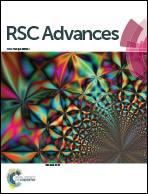Facile growth of Bi2MoO6 nanosheet arrays on Ni foam as an electrode for electrochemical applications
Abstract
A facile hydrothermal reaction has been developed for the large-scale growth of Bi2MoO6 nanosheets on conductive substrates with robust adhesion as high performance electrodes for electrochemical capacitors. It was found that the nickel foam facilitates the formation of a uniform nanosheet array with fast electron and ion transportation, a large electroactive surface area and an excellent structural stability. As a result, it shows a specific capacitance of 37.3 F g−1 even at a current density of 2 A g−1 and a high cycling stability with 89% retention of its initial specific capacitance after 1000 cycles in 1 M KCl solution. These results provide a way of fabricating Bi2MoO6 nanosheet arrays as efficient electrodes for electrochemical capacitors.


 Please wait while we load your content...
Please wait while we load your content...